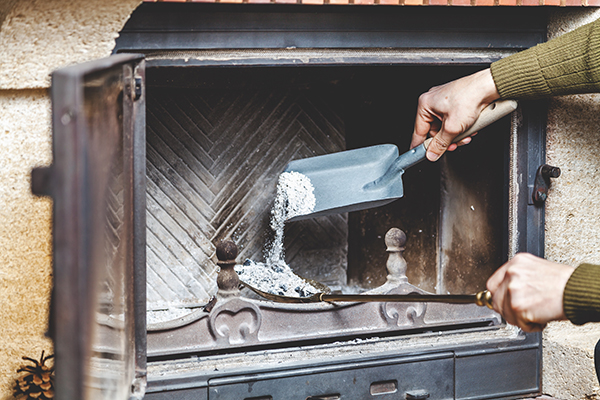
The winter weather came early this year and it doesn’t look as though it’s leaving anytime soon. However, there are still some steps you can take to combat the cold weather and problems it can bring to your chimney and fireplace. Here are five tips for winter fireplace and chimney care to keep your fireplace working well and prevent any problems the cold weather can cause.
Check Your Chimney Cap
Start your winter fireplace and chimney care at the top – beginning with your chimney cap. Chimney caps stop a myriad of problems from water damage to animals nesting in your chimney. They also prevent debris from accumulating in your chimney.
There is an increased chance of blockage from animals or debris in chimneys without a cap. The absence of a chimney cap and resulting greater chance of debris, leaves you at a higher risk for carbon monoxide build-up during winter fireplace usage.
Additionally, chimney caps will deteriorate over time. This is one reason chimney inspections are so important, and scheduling one soon is a good idea if you haven’t had a cleaning or inspection lately. Even though summertime is the ideal time for a chimney inspection, it’s better to get it scheduled now than to wait for next summer.
Keep the Firebox Clean
Keeping your firebox clean is one of the most basic winter fireplace tips. It should not be surprising to learn that the more you use your fireplace, the more often the firebox needs to be cleaned. Ideally it should be cleaned after every use, and after the fire has completely gone out and the ash has thoroughly cooled.
The substances left behind from combustion can be corrosive. They can cause damage to the fireplace, masonry or any andirons or other metals inside the fireplace. In addition to material damage, these byproducts are also toxic – creating risks for curious animals, children or even adults who may inhale it in small quantities.
During the winter it isn’t necessary to remove all the ash. You can leave a small layer to help insulate the fireplace during use. Just remember that once the weather starts warming up again, you should clear all the ash out of the firebox.
Don’t Let Your Chimney Liner Wear Out
The function of a chimney liner is to protect the interior of your masonry from the heat of your fireplace. Unlike the brickwork of your chimney, chimney liners are designed to withstand much higher and consistent temperatures. Because of this, the moment a chimney liner is breached by cracking, it becomes a fire hazard. A damaged liner increases your chances of a chimney fire.
As time goes on, older liners - especially ceramic liners - are susceptible to damage and can develop cracks or holes. Practically speaking, most homeowners won’t be able to identify a damaged liner. It is very important that you make sure not to skip regular inspections! Winter fireplace and chimney care includes checking the integrity of your chimney liner and replacing your liner if necessary.
Beware of Freezing & Thawing Damage
Spalling is the term used in masonry when the brick - quite literally - begins to fall apart piece by piece. Moisture gets inside the porous brick in the winter and then freezes, expanding and weakening the bricks. This process starts slow, but the deterioration speeds up as the brick cracks and chunks fall off, creating gaps.
A majority of moisture can be kept from entering the chimney or fireplace with a solid chimney cap, but exterior moisture can still work its way through the upper part of the chimney.
Over time, your chimney may suffer a lot of damage from repeated exposure to the harsh Midwest winter weather. The easiest way to keep an eye on spalling and winter fireplace damage is with annual chimney inspections. A certified chimney sweep will be able to recommend solutions for spalling, such as sealants to protect the brickwork from moisture.
It is important to note that paint or other sealers that can trap moisture inside the chimney should not be used. According to the Chimney Safety Institute of America (CSIA), “Several products have been developed specifically for use as waterproofing agents on masonry chimneys.” Since these specially formulated products are 100% vapor permeable, they allow moisture to escape while still preventing outside moisture to enter.
Watch Out for the Stack Effect
The stack effect is not referring to a tall deli sandwich, a triple cheeseburger, or even a dishonest card player. The stack effect describes the way air pressure and dramatically different temperatures work in your chimney.
In some cases the stack effect can cause back-drafts. This situation forces cold air directly into your home. Sometimes it can even exhaust smoke back into your home. If your negative pressure is pulling cold air into your home, it may make even the act of starting a fire difficult.
Stack effect does worsen with taller buildings. However, it can still make upper areas of your home too warm and lower areas too cold. This effect can happen even with just a second floor in your home. To prevent cold air from leaking inside and disrupting the temperature difference as well as the pressure in your home, look to seal any potential air leaks. These air leaks can occur in anything from windows to pipe fittings lower in your home. When taking winter fireplace and chimney care into consideration, schedule your inspection and don’t forget to address areas of current or potential cold air leaks.
Prevent Winter Chimney Damage – Call Doctor Flue!
If your chimney hasn’t been inspected or cleaned this year, contact us today! Doctor Flue offers chimney services in Michigan and Ohio and can inspect your chimney and identify any potential risks. We’ll get you set up right away so you can have peace of mind.
Call Us: 1-800-438-3583
Email Us: office@drflue.com
Office Hours: Mon-Fri: 8am-4pm
Connect with Doctor Flue on Social Media

